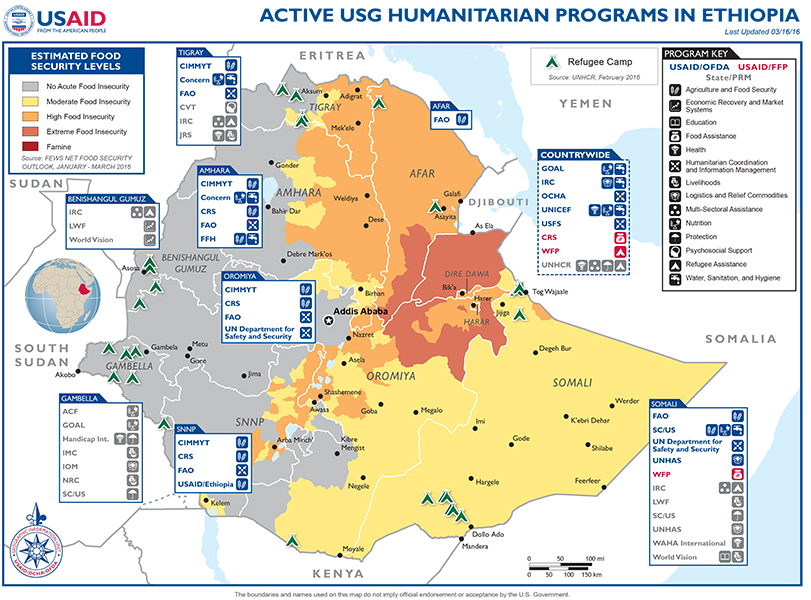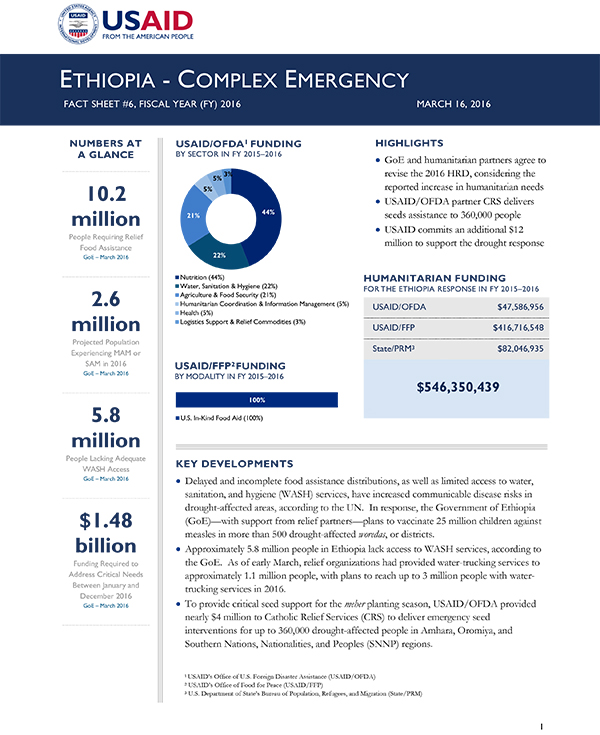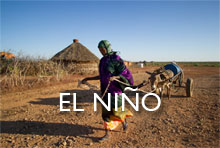- What We Do
- Agriculture and Food Security
- Democracy, Human Rights and Governance
- Economic Growth and Trade
- Education
- Ending Extreme Poverty
- Environment and Global Climate Change
- Gender Equality and Women's Empowerment
- Global Health
- Water and Sanitation
- Working in Crises and Conflict
- Disaster Assistance
- Political Transition Initiatives
- Conflict Mitigation and Prevention
- Countering Violent Extremism
- Disaster Risk Reduction
- Peacebuilding and Reconciliation
- Providing Safe & Secure Environments for Development
- Recovering From Crisis
- Resilience
- Tech Challenge for Atrocity Prevention
- World Humanitarian Day
- U.S. Global Development Lab
March 16, 2016
Highlights
GoE and humanitarian partners agree to revise the 2016 HRD, considering the reported increase in humanitarian needs
USAID/OFDA partner CRS delivers seeds assistance to 360,000 people
USAID commits an additional $12 million to support the drought response
Key Developments
Ethiopia Map - 03-16-2014 ![]() (pdf - 806k)
(pdf - 806k)
Numbers At A Glance
10.2 million
2.6 million
5.8 million
$1.48 billion
Humanitarian Funding
For the Ethiopia Response
FY 2015 - 2016
| USAID/OFDA | $47,586,956 |
| USAID/FFP | $416,716,548 |
| State/PRM | $82,046,935 |
| TOTAL | $546,350,439 |
Delayed and incomplete food assistance distributions, as well as limited access to water, sanitation, and hygiene (WASH) services, have increased communicable disease risks in drought-affected areas, according to the UN. In response, the Government of Ethiopia (GoE)—with support from relief partners—plans to vaccinate 25 million children against measles in more than 500 drought-affected woredas, or districts.
Approximately 5.8 million people in Ethiopia lack access to WASH services, according to the GoE. As of early March, relief organizations had provided water-trucking services to approximately 1.1 million people, with plans to reach up to 3 million people with water-trucking services in 2016.
To provide critical seed support for the meher planting season, USAID/OFDA provided nearly $4 million to Catholic Relief Services (CRS) to deliver emergency seed interventions for up to 360,000 drought-affected people in Amhara, Oromiya, and Southern Nations, Nationalities, and Peoples (SNNP) regions.
CURRENT EVENTS
Given deteriorating humanitarian conditions in Ethiopia, the UN reports that the GoE and humanitarian partners plan to update the 2016 Humanitarian Requirements Document (HRD), which outlines anticipated humanitarian needs and required funding levels between January and December 2016. HRD revisions include increasing the population projected to experience moderate acute malnutrition (MAM) from 1.7 million to 2.2 million people and adjusting the population expected to face severe acute malnutrition (SAM) from 435,000 to 450,000 children younger than five years of age. In addition, farmers requiring emergency seed support have increased from 2.2 million to 3.3 million people. The GoE is also receiving ad hoc requests for food assistance to support drought-affected populations not initially included in the HRD.
During 2015, the number of hotspot priority one districts—areas requiring urgent humanitarian support—more than quadrupled from 40 districts in February 2015 to 186 districts in December 2015. The GoE and humanitarian partners are currently reassessing hotspot priority one classifications and expect to release an updated list in the coming weeks. Hotspot classifications consider the impact of food availability, WASH infrastructure, access to markets, the nutrition situation, and other contributing factors.
AGRICULTURE AND FOOD SECURITY
Following the 2003 drought in Ethiopia, the GoE established emergency task forces for agriculture, health, nutrition, and WASH to improve coordination, mobilize resources, and strengthen technical assistance. In response to the current drought and deteriorating agriculture conditions, the GoE Disaster Risk Management–Agriculture Task Force (DRM-ATF) has established emergency seed and livestock working groups to coordinate relief efforts.
The DRM–ATF has reported adequate seed stocks in the country, and the Emergency Seed Working Group is matching farmer seed requirements with available seed crop and varieties. As of early March, the Emergency Seed Working Group had revised the projected population requiring seed assistance from approximately 477,000 to 838,000 households. In addition, the Emergency Livestock Working Group has revised the estimated number of livestock requiring feed support, as well as the required volume of feed, bringing total livestock funding requirements to nearly $150 million.
Food security and access to safe drinking water across Afar Region continue to deteriorate due to the ongoing drought, generating increased reliance on relief food assistance among agro-pastoral and pastoral households. More than 1 million people in the region are receiving relief food assistance, and an estimated 1.8 million livestock are facing acute feed shortages—affecting at least 118,000 households, according to a recent USAID assessment. Drought conditions in Afar have already resulted in the death of approximately 105,000 cattle, more than 440,000 goats and sheep, nearly 15,000 camels, and an estimated 4,500 donkeys. During February, worsening livestock body conditions resulted in reduced livestock prices compared to 2014 and 2015, while the price of staple foods increased due to decreased cereal supplies in local markets, according to a recent USAID assessment.
In Afar and Somali regions, the UN Food and Agriculture Organization (FAO)—with $700,000 in FY 2016 USAID/OFDA support—is supporting emergency livelihood interventions for drought-affected pastoral, agro-pastoral, and smallholder farming communities. In addition, USAID/OFDA supports countrywide rapid response platforms for nutrition and WASH, operated by GOAL and the International Rescue Committee (IRC), which enable a flexible scale-up of emergency response activities in areas of Afar requiring urgent assistance.
USAID/OFDA recently provided CRS with nearly $4 million to support emergency seed interventions for the meher planting season, benefiting up to 360,000 people in Amhara, Oromiya, and SNNP. CRS is also providing agricultural trainings regarding integrated pest management, crop protection, and promotion of hermetic technologies—airtight storage—to enhance grain and seed security.
Food for the Hungry (FFH), with more than $1.5 million in FY 2016 USAID/OFDA support, is providing access to safe drinking water and safeguarding livelihood assets across four districts in Amhara. FFH is delivering critical livestock feed to support drought-affected populations in South Gondar and Wag Himra zones, while providing emergency water-trucking services to populations facing severe water shortages in Wag Himra.
NUTRITION AND HEALTH
Nutrition conditions in Ethiopia remain concerning, and the GoE Ministry of Health reported that relief organizations treated nearly 25,200 SAM cases in January 2016, surpassing the January SAM caseload in 2015. To scale up its rapid emergency response capacity, the UN Children’s Fund (UNICEF) had trained nearly 23,000 health care workers on SAM case management, 20 UNICEF staff on emergency response activities, and nine monitors to oversee community-based management of acute malnutrition and infant and young child feeding programs as of early March.
Delayed and incomplete food assistance distributions, as well as limited access to WASH services, has increased communicable disease risks in drought-affected areas, according to the UN. In particular, lack of safe drinking water has resulted in increased incidence of diarrheal diseases, exacerbating acute malnutrition. Health actors report that morbidity and mortality risks associated with measles increase significantly when affected populations are experiencing acute malnutrition. In response, the GoE—with support from relief partners—plans to vaccinate 25 million children against measles in more than 500 drought-affected districts.
USAID/OFDA recently provided nearly $2.7 million to Save the Children/U.S. (SC/US) to support life-saving nutrition, WASH, and emergency feed and fodder interventions for more than 130,000 people in drought-affected areas of Somali. In addition, UNICEF, with more than $8.9 million in FY 2015 and FY 2016 USAID/OFDA funding, is delivering emergency health, nutrition, and WASH interventions to vulnerable populations across Ethiopia.
WASH AND PROTECTION
Approximately 5.8 million people in Ethiopia are expected to require emergency WASH assistance during 2016, according to the GoE and relief organizations. As of January, UNICEF reported that 1.2 million people had received WASH assistance—including repairing and upgrading water sources, constructing new water supply systems, extending water pipelines, installing rainwater harvesting and storage systems, and training water management committees.
The WASH Cluster—the coordinating body for humanitarian WASH activities, comprising UN agencies, non-governmental organizations, and other stakeholders—had provided water-trucking services to approximately 1.1 million people as of early March and plans to target 3 million people with emergency water-trucking assistance during 2016. To help reduce costs for urgent WASH interventions, UNICEF and the GoE may utilize in-kind truck contributions from the private sector to support water-trucking efforts.
On March 4, GoE officials in SNNP’s Sidama Zone reported that nearly 90 percent of open water sources, primarily ponds, are dry. District-level authorities in the region are rationing water used by schools, and GoE officials requested increased support from relief organizations to provide access to safe drinking water for affected populations. Children often walk long distances to retrieve safe drinking water, as underground water sources continue to deplete; an undetermined number of children—particularly girls—are not attending school to collect safe drinking water.
In FY 2015 and to date in FY 2016, USAID/OFDA has provided $11.5 million to support GOAL’s rapid response nutrition platform to treat acute malnutrition among vulnerable populations, benefiting up to 1.8 million people. Given that lack of access to safe drinking water may exacerbate acute malnutrition, USAID/OFDA recently provided GOAL with an additional $1.5 million to deliver complementary WASH interventions—including provision of buckets, soap, and water purification agents—to reduce infectious disease incidence among drought-affected populations. GOAL is also training more than 3,200 health care workers on critical WASH challenges; providing 120 health centers with 10,000-liter water storage tanks; supplying 20 health centers with incinerators; and constructing latrines at four health facilities.
INTERNATIONAL ASSISTANCE
In late January, the Government of Germany pledged nearly $46 million in additional funding to support relief efforts in Ethiopia, including treatment of acute malnutrition, procurement of seed and fodder, WASH interventions, and cash-for-work support. Since 2011, the Government of Germany has contributed more than $88 million to support drought resilience and response programs in Ethiopia.
CONTEXT
Multiple consecutive seasons of below-normal rainfall—exacerbated by the effects of the El Niño climatic event—have resulted in deteriorating agricultural, livestock, food security, and nutrition conditions in northeastern and central Ethiopia. By March 2016, the GoE estimated that 10.2 million people required relief food assistance and other humanitarian interventions.
USAID activated a DART on February 24, 2016, to lead the USG crisis response to the drought in Ethiopia. Under the strong leadership of the GoE, the DART is coordinating USG response activities in close partnership with the UN and other relief organizations. The DART—composed of humanitarian specialists based in Ethiopia—is addressing critical needs and examining ways to realign activities to respond to urgent assistance gaps. USAID also established an Ethiopia Drought RMT based in Washington, D.C., to support emergency response efforts in Ethiopia.
While drought remains a major contributor to vulnerability in Ethiopia, negatively affecting the lives and livelihoods of farmers and pastoralists, populations also continue to confront other challenges—including seasonal flooding, localized intercommunal conflict, above-average food prices, disease outbreaks, and limited access to health and WASH services—that contribute to sustained humanitarian needs and an ongoing complex emergency in Ethiopia.
On October 7, 2015, U.S. Chargé d’Affaires, a.i., Peter H. Vrooman redeclared a disaster for Ethiopia in response to the ongoing complex emergency.
PUBLIC DONATION INFORMATION
The most effective way people can assist relief efforts is by making cash contributions to humanitarian organizations that are conducting relief operations. A list of humanitarian organizations that are accepting cash donations for disaster responses around the world can be found at www.interaction.org.
USAID encourages cash donations because they allow aid professionals to procure the exact items needed (often in the affected region); reduce the burden on scarce resources (such as transportation routes, staff time, and warehouse space); can be transferred very quickly and without transportation costs; support the economy of the disaster-stricken region; and ensure culturally, dietary, and environmentally appropriate assistance.
More information can be found at:
- USAID Center for International Disaster Information: www.cidi.org or +1.202.821.1999.
- Information on relief activities of the humanitarian community can be found at www.reliefweb.int.










Comment
Make a general inquiry or suggest an improvement.